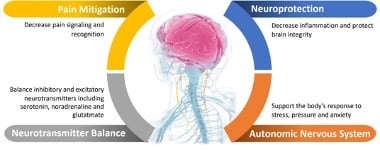How does nVNS help with primary headache disorders?
The four mechanisms of action of nVNS through stimulation of the cervical branch of the vagus nerve are summarised in below figure:

The underlying mechanism for transcervical VNS (tcVNS) in headache treatment is believed to be similar to invasive VNS. In particular, the involvement of locus coeruleus (LC), dorsal raphe nucleus, periaqueductal gray, ventral posteromedial nucleus, and cingulate cortex from VNS. The involvement of the different regions of the brain is reflected in the role of norepinephrine, serotonin, and central sensitization underlying the pathophysiology of different headache disorders (Yuan and Silberstein, 2017).
tcVNS has been studied on several primary headache disorders (Migraine - with or without aura, cluster headache, hemicrania continua etc.) (Yuan and Silberstein, 2017)
- Migraine
- TcVNS exhibits a prophylactic effect in chronic migraine patients.
- Cluster headache
- This group of headaches are characterized by attacks of excruciating unilateral pain associated with ipsilateral cranial autonomic features (de Coo et. al., 2019)
- Long-term use of nVNS has been shown to sustainably reduce the severity of the attacks (Gaul et. al., 2017).
- Hemicrania continua
- Hemicrania continua (HC) is a persistent, strictly unilateral, chronic primary headache classified as a trigeminal autonomic (TAC).
- Individuals afflicted with HC experience permanent disposition of moderate pain, and the exacerbations of severe intensity accompanied by signs of lacrimation, ptosis/miosis or nasal congestion/rhinorrhea (Eren et. al., 2016).
- Non-invasive VNS has also been shown to reduce pain severity of the constant pain between 40-80% (Tso et. al., 2017).
- Paroxysmal hemicrania
- Medication overuse headache
The Byond Healthcare knowledge hub shares expert content about the vagus nerve and the benefits of vagus nerve stimulation, with a specific focus on non-invasive vagus nerve stimulation, with individuals, healthcare providers and medical representatives.